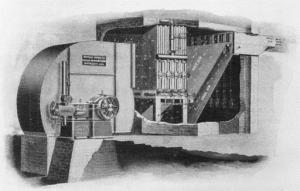The History of Air Conditioning
/JCW Energy Services have been installing complex HVAC through to standard air conditioning systems for over 20 years. We pride ourselves in keeping up with modern advances in this technology and ensuring that our staff are fully trained in the installation and maintenance of the equipment.
We can quite easily take these essential systems for granted. We walk into a high street shop and we expect the environment to be of a comfortable temperature or we don't shop there. At work it is our employers responsibility to ensure we are cool or warm enough to conduct our work. Air conditioning systems are all around us, in hospitals, banks, schools and hidden away in critical areas such as server rooms and data centres.
It is hard to imagine a life without air conditioning, so how did it all start? Read on to learn a little about the history of air conditioning through a few land mark inventions and how these transformed our lives.
Ancient History
In ancient Egypt reeds were hung in windows and moistened by trickling water. The air blowing through the window was then cooled by the evaporating water. This made the air more humid which was extremely beneficial in a dry desert climate. To cool houses In ancient Rome, water from aqueducts was circulated through the walls.
Snow and ice were used for cooling since prehistoric times. Ice being harvested during the winter months and being stored for use in the summer time became popular in the late 17th century.
The Ventilator - 1700's
In 1736, the English House of Commons was cooled by a seven-foot, hand-cranked “blowing wheel,” which acted as a giant fan. The man at the helm of the crank was called the Ventilator.
The principles of Mechanical Cooling were first explored back in 1758 when Benjamin Franklin and John Hadley experimented with the principle of evaporation to rapidly cool an object. They confirmed that evaporation of highly volatile liquids could drive down the temperature of an object past the freezing point of water.
Franklin concluded “From this experiment one may see the possibility of freezing a man to death on a warm summer's day”.
The Evils of High Temperatures - 1800's
In the 1840's, physician and inventor Doctor John Gorrie from Florida, proposed the idea of cooling areas within the cities to relieve the inhabitants of ‘the evil of high temperatures’. Gorrie believed that cooling was the key to not only avoiding diseases such as malaria but will also make people more comfortable. However, his rudimentary system for cooling a hospital room for example, required ice to be shipped to Florida from frozen lakes in northern United States.
This logistical challenge was expensive and time consuming so Gorrie started experimenting with the concept of artificial cooling. In 1851 he designed and patented a machine that created ice using a compressor powered by a horse, water, wind driven sails or steam. Although Gorrie was unsuccessful in bringing this technology to the market place, his invention laid the foundation for the modern air conditioning and refrigeration systems we use today.
Controlling Temperature and Humidity - 1900's
On 17 July 1902 the first air conditioner, built and designed by Willis Carrier, began working. Carrier had been experimenting with air conditioning as a way to solve an application problem for a publishing company. This system was designed to control not only the temperature but also the humidity to improve the manufacturing process in the printing plant.
Carrier was knowledgeable in the heating of objects and simply reversed the process by sending air through cold coils (filled with cold water) as opposed to through hot coils. This cooled the air and also controlled the moisture in the air helping maintain consistency with paper dimensions and ink alignment.
Carrier later formed The Carrier Air Conditioning Company of America to meet the rising demand for this technology and soon air conditioning was used not only in commercial buildings but also to improve comfort in homes and automobiles.
Developing Refrigerant
The early air conditioning systems and refrigerators used toxic or flammable gases such as ammonia, methyl chloride or propane. These dangerous gases could cause fatal accidents when they leaked. The first non-flammable, non toxic chlorofluorocarbon gas was created by Thomas Midgley Jr. in 1928, called Freon. This is the trademark name for any chlorofluorocarbon (CFC), hydrochlorofluorocarbon (HCFC) or hydroflourocarbon (HFC) refrigerant. The refrigerant name then includes a number indicating the molecular composition such as R22 or R410A.
Modern refrigerants have been developed to be more environmentally safe. CFCs have been and HCFCs are being phased out and being replaced with HFCs, Concerns that these too contribute to climate change problems means that these gases will continue to be developed to favour ozone and climate safe refrigerant.
Cooling the 21st Century
This life changing technology has brought concerns with regard to environmental impacts. Increasing energy efficiency and using new refrigerants that reduce hydroflourocarbon (HFC) emmissions are paramount in the evolution of air conditioning systems. The European phase-down of HFC's has already begun in earnest with new F-gas regulations introduced in 2015.
To further reduce energy usage, manufacturers now stretch the capabilities of the thermostat by developing sophisticated microprocessor based diagnostic and control kits that can automate the operation of the system. This allows the user to adjust functions and settings from off-site, web enabled devices and even send email or text alerts when a system is in fault or requires a filter change.
Today, air conditioning units can be activated by simply flipping a switch and are complex electromechanical systems which are the product of a century of engineering development. Some would say that air conditioning/refrigeration is one the 10 greatest mechanical engineering achievements of the 20th century.
The next 15 years will see major changes in the industry. JCW Energy Services will ensure we are at the forefront with regard to having the knowledge, expertise and qualified engineers to install and maintain air conditioning systems of the future.
Click here to read more about the next generation refrigerant - R32.
Are you planning an installations project? Click here to download our most recent eBook - A Guide to HVAC Project Planning.
You may also be interested to read our most recent Case Study regarding a recent installations project to an extremely prestigious building in Plymouth. Click here to find out more.















